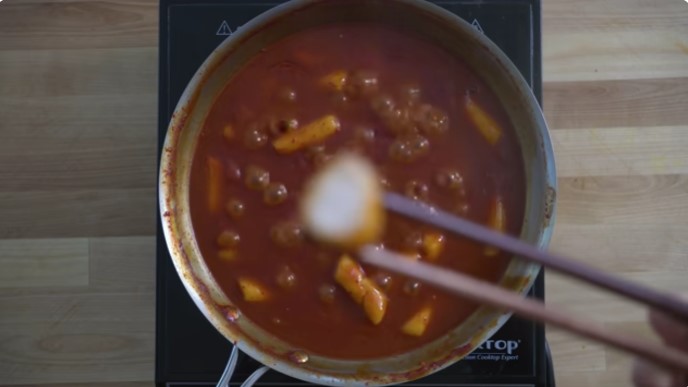Is Tteokbokki Halal
Tteokbokki, a beloved Korean street food, captivates many with its unique blend of flavors and chewy texture. This dish, often found sizzling in spicy, sweet sauces at bustling street markets, has piqued the curiosity of many, especially within the Muslim community. The pressing question is: Is tteokbokki halal? Let’s delve into the details to uncover the answer.
Introduction
Tteokbokki is more than just a dish; it’s a cultural experience. Originating from Korea, this comfort food consists primarily of cylindrical rice cakes (tteok) drenched in a vibrant red sauce made from gochujang (Korean chili paste). The combination of chewy rice cakes with a sauce that’s both spicy and sweet offers a taste different from anything else. Whether you’re strolling through the streets of Seoul or exploring a Korean restaurant in your hometown, tteokbokki’s appeal is universal. But for Muslim consumers, ensuring that this dish adheres to halal dietary laws is crucial. This comprehensive guide aims to address these concerns, examining the ingredients, preparation methods, and where to buy halal-certified tteokbokki.

Understanding Tteokbokki
Ingredients
The traditional ingredients for tteokbokki include:
- Rice cakes (tteok): Made from rice flour, water, and salt.
- Gochujang (chili paste): A key component that provides the dish’s signature heat.
- Soy sauce, sugar, and garlic: These enhance the flavor profile.
Halal Considerations
- Rice Cakes: These are typically halal as they contain basic ingredients like rice flour, water, and salt.
- Gochujang: This is where scrutiny is needed. While chili paste is generally halal, some versions might contain alcohol or other non-halal preservatives. Always check the label for halal certification.
- Soy Sauce: Some soy sauces may contain alcohol as a byproduct of fermentation. Opt for those that are halal-certified.
- Additional Ingredients: Tteokbokki sometimes includes fish cakes, meat, or seafood. Ensure any animal products are sourced from halal-certified suppliers.
Making Halal Tteokbokki
Steps to Ensure Halal Compliance
- Check Labels: Always verify that each ingredient, especially gochujang and soy sauce, is halal-certified.
- Halal Butchery: If meat or seafood is included, it must be from halal sources.
- Substitute Ingredients: Use halal-certified alternatives for any questionable ingredients.
Recipe
Here’s a simple recipe to make halal tteokbokki:
Ingredients:
- 300g rice cakes
- 2 tablespoons halal-certified gochujang
- 1 tablespoon halal soy sauce
- 1 tablespoon sugar
- 2 cloves garlic, minced
- 2 cups water
- Optional: fish cakes, boiled eggs, or vegetables (all halal-certified)
Instructions:
- Soak Rice Cakes: If using store-bought rice cakes, soak them in water for 10-15 minutes.
- Prepare Sauce: In a pot, combine water, gochujang, soy sauce, sugar, and garlic. Bring to a simmer.
- Add Rice Cakes: Add soaked rice cakes to the sauce. Cook until they become soft and chewy.
- Add Optional Ingredients: If using fish cakes or other add-ins, ensure they are halal-certified and add them to the pot. Cook until everything is heated through.
- Serve: Garnish with sesame seeds or scallions and serve hot.
Where to Buy Halal Tteokbokki
Stores and Markets
- Korean Grocery Stores: Many Korean grocery stores now offer halal sections. Look for halal-certified gochujang and soy sauce.
- Online Retailers: Websites like Amazon and specialty Asian food sites often have halal-certified versions of key ingredients.
- Halal Markets: Some halal markets might carry pre-made halal tteokbokki or the necessary ingredients.
Dining Out
- Halal Korean Restaurants: Some Korean restaurants, particularly in areas with large Muslim populations, offer halal-certified tteokbokki.
- Street Markets in Korea: Certain stalls in popular markets like Myeongdong are known for offering halal options. Always ask vendors about halal certification.
Frequently Asked Questions
What ingredients are typically used in tteokbokki?
Tteokbokki is made primarily with rice cakes (tteok) and a spicy sauce. Other common ingredients include fish cakes, boiled eggs, green onions, and various vegetables like cabbage and carrots.
Can I make tteokbokki less spicy?
Yes, you can adjust the spiciness of tteokbokki by reducing the amount of gochujang (Korean chili paste) or using a milder sauce. Adding more sugar or honey can also help balance the heat.
How should I store leftover tteokbokki?
Store leftover tteokbokki in an airtight container in the refrigerator for up to three days. For longer storage, you can freeze it for up to two to three months.
What is the best way to reheat tteokbokki?
Reheat tteokbokki on the stovetop with a splash of water or broth to prevent it from drying out. You can also use a microwave by heating it in intervals and stirring in between.
Are there any variations of tteokbokki?
Yes, there are many variations of tteokbokki. Some popular ones include cheese tteokbokki, seafood tteokbokki, and carbonara tteokbokki. Each variation adds unique flavors to the traditional dish.
Can I find halal tteokbokki?
Yes, halal tteokbokki is available. Some specialized Korean restaurants and online stores offer halal versions of this popular dish.
Where can I buy tteokbokki ingredients?
You can buy tteokbokki ingredients at Korean supermarkets and online grocery stores. Look for rice cakes, gochujang, and other ingredients at stores like H Mart, Shine Korea, and Koryo Mart.
Is tteokbokki suitable for vegetarians?
Traditional tteokbokki contains fish cakes, but you can easily make a vegetarian version by omitting the fish cakes and using vegetable broth instead of fish broth.
How long does it take to cook tteokbokki?
Tteokbokki typically takes about 15-20 minutes to cook. The rice cakes need to be boiled until they are soft and chewy, and then simmered in the sauce with other ingredients.
Can I add cheese to tteokbokki?
Yes, adding cheese to tteokbokki is a popular variation. Cheese can be added on top of the cooked tteokbokki and melted in the oven or microwave for a creamy twist.
Is tteokbokki gluten-free?
The rice cakes in tteokbokki are naturally gluten-free, but some gochujang brands may contain wheat. Look for gluten-free gochujang if you need to avoid gluten.
How can I make tteokbokki at home?
You can make tteokbokki at home by boiling rice cakes until soft, then simmering them in a sauce made of gochujang, sugar, soy sauce, and water. Add fish cakes, vegetables, and other desired ingredients.
Can I find tteokbokki in restaurants outside Korea?
Yes, many Korean restaurants around the world serve tteokbokki. You can also find it at Korean food stalls and specialized tteokbokki restaurants in larger cities.
What is the origin of tteokbokki?
Tteokbokki originated in Korea and was initially a royal court dish. Over time, it evolved into a popular street food enjoyed by many.
How is tteokbokki traditionally served?
Tteokbokki is traditionally served hot, often garnished with sesame seeds and green onions. It can be enjoyed as a snack, appetizer, or main dish.
Can I use other types of rice cakes in tteokbokki?
Yes, while cylindrical rice cakes are commonly used, you can experiment with different shapes and types of rice cakes to create various textures and appearances in your tteokbokki.
Conclusion
Tteokbokki can be enjoyed by Muslim consumers if careful attention is paid to ingredient sourcing and preparation. By choosing halal-certified products and verifying the ingredients, you can savor this delicious Korean dish without compromising your dietary principles. Whether you’re making it at home or seeking it out in restaurants, there are ample opportunities to indulge in this spicy, sweet, and chewy delight.
Read also: Is Kimchi Halal





